On 17 February 1987, during one of the bloodiest periods of the Lebanese Civil War (1975-1990), the prominent journalist, literary critic, intellectual, and activist Husayn Muruwwah (or Hussein Mroué[i]) was assassinated at his home in Ramlet al-Baida, West Beirut. Muruwwah left Lebanon at the age of fourteen to train at the Najaf hawza (seminary) in Iraq. He intended to follow in the footsteps of his father, who was a respected religious scholar and cleric. Yet after a multifaceted intellectual journey that spanned several decades and multiple locations, Muruwwah went on to become a celebrated Marxist philosopher and senior member of the Lebanese Communist Party (LCP); “a Red mujtahid who was at once proud of the cultural heritage of Islam and politically committed to the cause of social justice, political freedom and emancipation from foreign domination along Communist lines.”[ii]
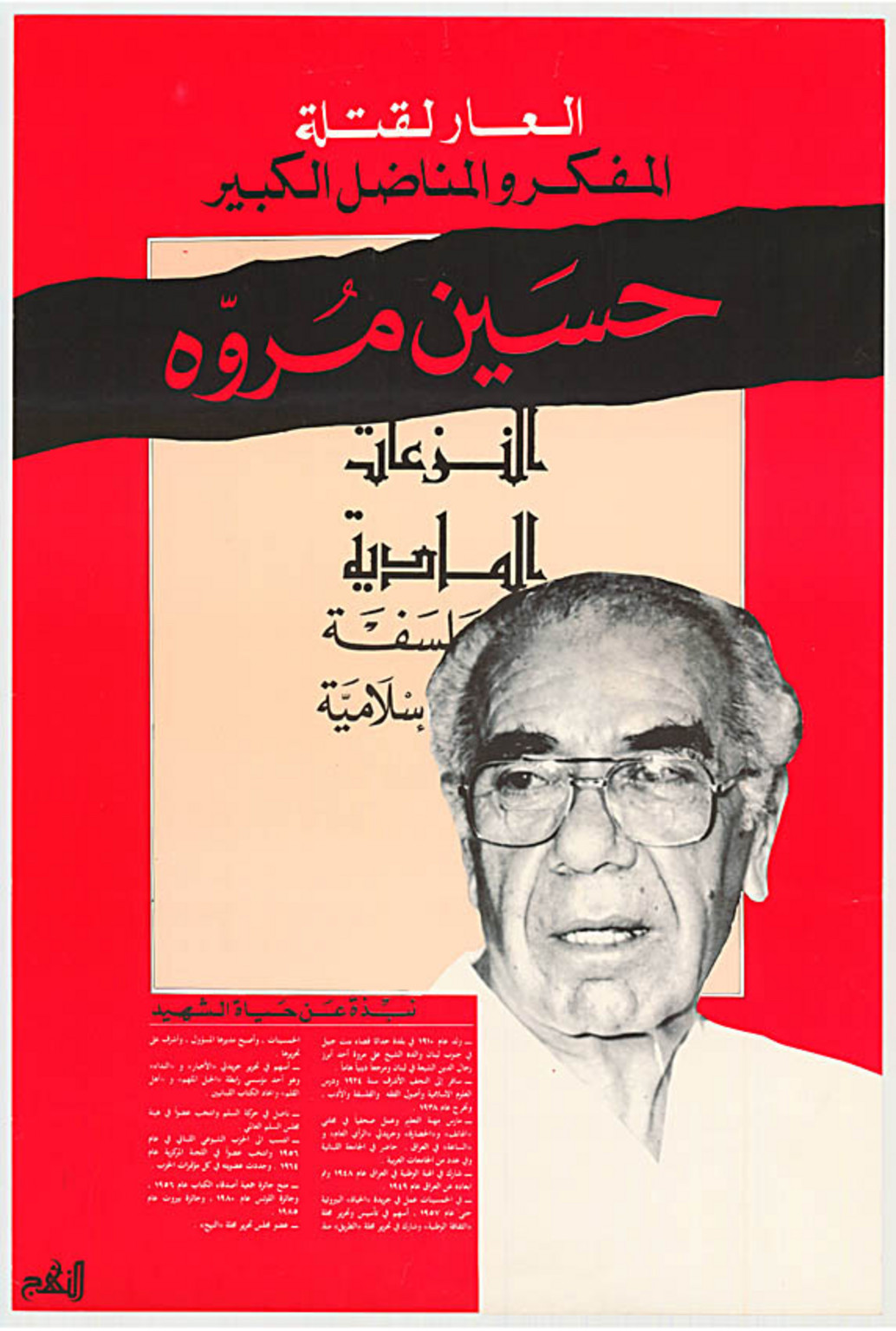
["Shame on the murderers of the great thinker and freedom fighter, Husayn Muruwwah." Iraqi Communist Party poster, 1987. Signs of Conflict Archive, Zeina Maasri Collection]
A prolific writer, Muruwwah once declared, “I cannot endure life without writing.” [iii] He wrote several books and hundreds of articles in his lifetime. Sadly, aside from selected extracts, none of this important and diverse body of work has ever been translated into English. This lack of translations has limited access to his work primarily to native Arabic speakers and academic specialists. This perhaps explains why Muruwwah has remained largely unknown outside of the Arab world. On the thirtieth anniversary of his murder, this essay intends to introduce Muruwwah’s life to a broader audience and encourage greater interest in his history and work. It is indebted to the small existing body of English-language scholarship already written on Muruwwah, details of which can be found in the reading list below.
Beginnings: “Born a Shaykh”
Muruwwah was born in 1908 or 1910 in the village of Haddatha in the Bint Jbeil district of the Nabatieh province of South Lebanon.[iv] The broader area, known as Jabal ‘Amil, is home of one the oldest Shi‘i communities in the Muslim world. Muruwwah was descended from a line of religious scholars and from a young age, his family groomed him to succeed his father, Ali. In Muruwwah’s own words, Ali was a “prominent and esteemed religious leader.”[v] In his autobiography Wulidtu shaykhan wa-amutu tiflan[vi] (I was Born a Shaykh and I’ll Die a Child), Muruwwah recalls a strict, almost non-existent childhood in which he was forced to wear the black robes and turban of a Shi‘i religious scholar from the age of eight, something for which his peers ridiculed him. Revealing the enormous pressure that was placed on him by others, Muruwwah remarked that as a boy, “my dream was to become a distinguished Shaykh like my father . . . no sorry, actually . . . that was the dream of my father, and then my mother, our family, our extended family, and all of Jabal ‘Amil.”[vii]
Men from Jabal ‘Amil had received religious schooling in Najaf for centuries. From the 1880s onward, this connection intensified as a group of local clerics returning to the region from Iraq led a renewal of its religious institutions and opened a number of new schools in villages and small towns.[viii] This trend served to strengthen links between Jabal ‘Amil and Najaf and ensure that from a young age Muruwwah was destined to study there. However, despite his father’s prestige, the family’s financial situation was not secure. Indeed, in 1912, Muruwwah’s brother, Hassan, like many thousands of other Lebanese at this time, had left the country and emigrated to South America in the hope of a better future. In 1920, Muruwwah’s father died suddenly, leaving the family in an even more precarious financial situation and jeopardizing his chances of being able to pursue his religious studies at all. Eventually, in 1924, following the intervention of Shaykh ‘Abd al-Husayn Sharraf al-Din, enough money was gathered from members of his family to send Muruwwah to study in Iraq.
Once in Najaf, the young Muruwwah was quickly surrounded by a host of intellectual influences in addition to those that were required by his loosely structured religious studies. Many of these were frowned upon or even forbidden by his teachers. In the city’s book market, Muruwwah was exposed to modern literature and poetry through issues of cultural and political magazines such as al-‘Usur, al-Thaqafah and al-Hilal. He was heavily influenced by the work of the Egyptian writer, Taha Husayn and other members of the nahdah movement, as well as the older Islamic reformist works of Muhammad ‘Abduh and Jamal al-Din al-Afghani. Muruwwah was also introduced to the concepts of atheism and Darwinism through articles by Shibli al-Shumayyil. Muruwwah had his first encounter with Marxism during this period too, through a novel by Farah Antun. As a result of these wide-ranging, often conflicting influences, Muruwwah began to have doubts about the traditional clerical education offered in Najaf and to question where his future lay.
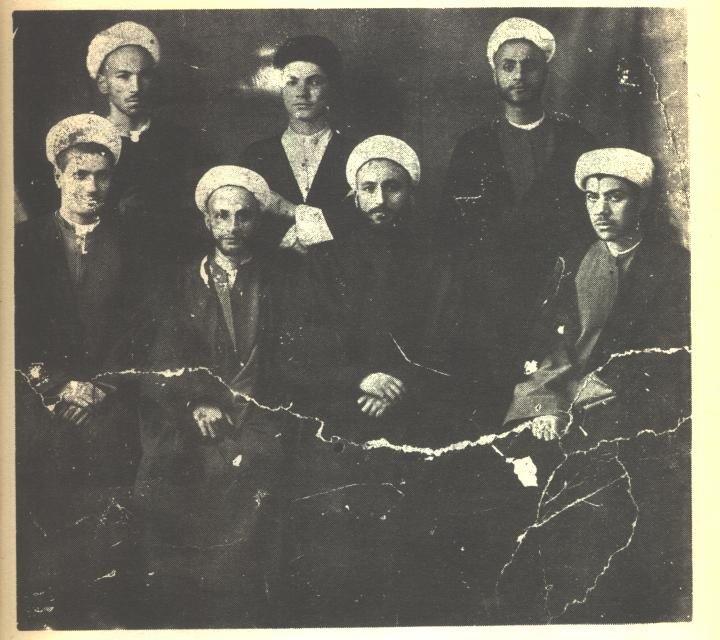
[Members of al-Shabiba al-‘Amiliyya al-Najafiyya (the Najafi-‘Amili Youth) c. 1927. Sitting from right to left: Husayn Murruwah, Muhammad Husayn al-Zein, Muhsin Shararah, and Muhammad Shararah. Standing from the right: unknown, Hashim al-Amin, ‘Ali al-Zein. With thanks to Ghassan Nasser]
However, Muruwwah was not alone and in 1925, he joined a group of like-minded students that came together to form al-Shabiba al-‘Amiliyya al-Najafiyya (the Najafi-‘Amili Youth). One member of this group, Muhsin Shararah, strongly criticized the ‘ulama (religious scholars) of Najaf in an article published in the modernist Shi`i journal al-Irfan. Shararah’s criticism caused something of a scandal, but undaunted, Muruwwah subsequently published an article in al-Irfan that supported his friend’s stance. He argued that “[i]t is about time…that we demand of those people who wish to protect religion and persuade the people in its truthfulness that they become men of culture; the culture of their compatriots and their contemporaries”.[ix] His decision to publicly support Shararah led to Muruwwah being rejected and censured by his teachers and many of his fellow students.
The spiritual and intellectual turmoil of this period evidently took its toll, for in 1928, Muruwwah suffered a nervous breakdown and returned to Lebanon. After a brief stay in his home country during which time he met his wife, Fatima Bazzi, Muruwwah then travelled to Syria to study law and literature at the University of Damascus with the financial assistance of a relative living in Argentina.[x] After his studies in Damascus, Muruwwah then lived and taught in Beirut, al ‘Amarah and Baghdad. In 1934, Muruwwah was persuaded to return to Najaf and complete his religious education, and he eventually did so in 1938 thus formally becoming a mujtahid.[xi]

[Husayn Muruwwah with his children, Nizar, Ahmad and Hassaan, 1936. With thanks to Ghassan Nasser]
Political Activities in Iraq
Muruwwah then took a role as a teacher of Arabic Language and Literature at a government secondary school in al-Nasiriyyah, Southern Iraq. According to his son Ahmad, it was at this time that Muruwwah took off his religious garb and began to wear layman’s clothing. He stayed in this role until 1941, when he moved to Baghdad to continue teaching and writing. It was during this period that he became more directly exposed to Marxist texts and explicitly Communist positions. He associated with members of the Iraqi Communist Party (ICP), and one of its founders, Husayn Muhammad al-Shabibi (who had also trained at the hawza in Najaf), gave him a copy of the Communist Manifesto and Lenin’s The State and Revolution.[xii] Although he expressed an affinity with Communist ideals, at this point, Muruwwah did not yet consider himself a Communist and did not join the ICP, preferring the Pan-Arab-orientated Hizb al-Istiqlal (Independence Party). The tumultuous political and economic conditions in Iraq at this time, notably after the events of the Second World War, during which Britain had invaded and re-occupied the country, pushed Muruwwah to engage in more overt political activities.
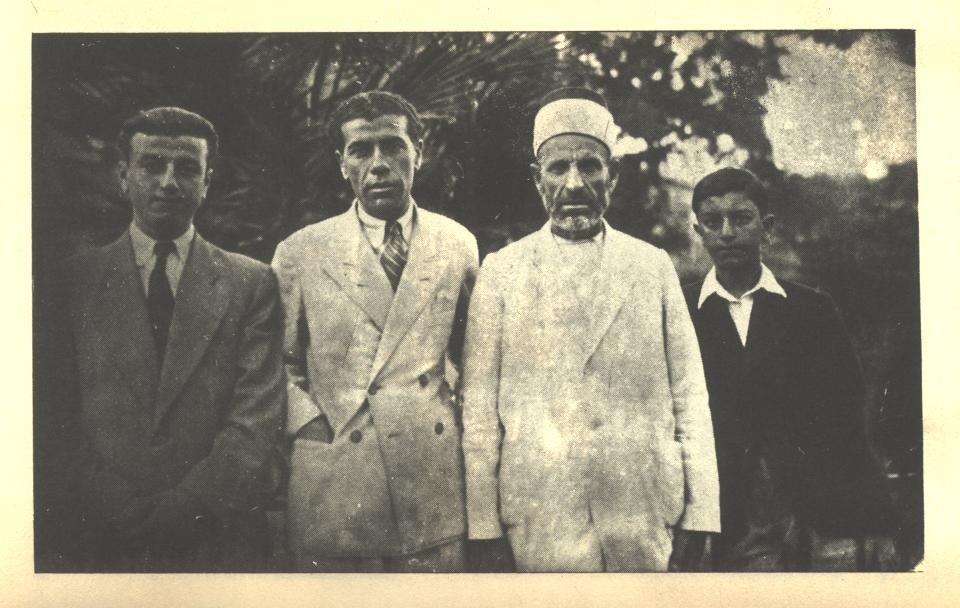
[Husayn with Ahmad Muruwwah and his sons Karim and Muhammad Husayn, 1945. With thanks to Ghassan Nasser]
Muruwwah’s engagement with Iraqi politics culminated in January 1948, when he actively participated in the mass uprising against the Portsmouth Treaty known as al-Wathba. He took part in street protests against the treaty (which contained a number of stipulations that infringed upon Iraq’s sovereignty to Britain’s benefit) and wrote critical articles in al-Ra’i al-Amm on a daily basis. During the government’s suppression of the uprising, in which the ICP had played a central role, several communists that Muruwwah knew personally were killed. This violence had a profound impact on him and acted as “the tipping point that pushed Muruwwah towards Communism”.[xiii] Events in Palestine at this time, notably al-Nakba, also served to heighten Muruwwah’s political consciousness and cemented his life-long commitment to the Palestinian cause. It is interesting to note that in the late 1940s, Muruwwah worked at a Jewish high school in Baghdad and left a strong, positive impression on a number of his Jewish Iraqi students. One such student, Albert Khabbaza, remembered Muruwwah as a “progressive gentleman” who “showed no ethnic discrimination” and was a “nationalist who hated the influence of the British in Iraq”.[xiv] Following the events of al-Wathba, the long-serving pro-British Prime Minister, Nuri al-Sa’id, returned to office. Subsequently, the ICP was brutally suppressed by the government and several members of its leadership, including al-Shabibi, were hanged in February 1949. The dead body of al-Shabibi was displayed publicly, something which Muruwwah himself witnessed. Not long after, Muruwwah was stripped of his Iraqi nationality and, together with his family, expelled from the country by al-Sa’id’s government.
A Return to Lebanon and Travels to Moscow
Following his expulsion from Iraq, Muruwwah returned home to Lebanon and settled in the capital, Beirut. Affected deeply by his experiences in Iraq, Muruwwah decided to become a Communist and in 1951, joined the Lebanese Communist Party (LCP).[xv] At this time, the LCP was the largest Communist party in the Middle East with approximately twelve thousand members and fifty thousand sympathizers.[xvi] Muruwwah began to write for al-Hayat and acquaint himself with other members of the LCP. The following year, in collaboration with Muhammad Dakrub and Faraj Allah al-Hilw, Muruwwah launched a cultural newspaper called al-Thaqafa al-Wataniyya for which he wrote regularly, as well as for al-Tariq.
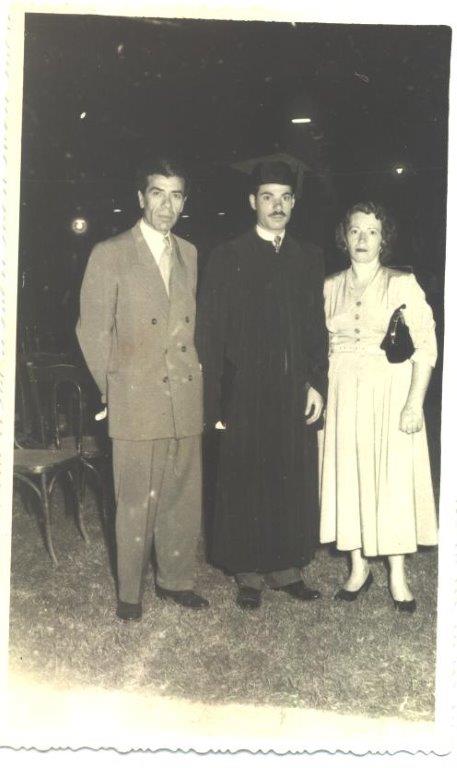
[Husayn Muruwwah with his wife, Fatima at their son Ahmad’s graduation from the American University of Beirut, 1956. With thanks to Ghassan Nasser]
In December 1954, Muruwwah attended the Second Congress of Soviet Writers in Moscow as a representative of the Lebanese branch of the Arab Writers’ Association. This first trip to Moscow impressed and deeply affected Muruwwah. He remarked that the relationship between the people and literature that he had witnessed there constituted “a unique interaction unprecedented in the history of humanity”[xvii]. He was struck by how Soviet writers were “of the people” and therefore their essential style was that of realism. Thus began Muruwwah’s long engagement with Socialist Realism, elements of which he began to apply to his writings on Arabic literature. In both al-Thaqafa al-Wataniyya and then al-Tariq, Muruwwah and his peers became involved in heated ma’arik adabiyyah (literary battles) that “redefined the sources of intellectual authority and invested literary criticism with a new sense of purpose”.[xviii] Simultaneously, in a reflection of the tense political climate in Lebanon (and throughout the Middle East) at this time, Muruwwah also prepared for battle more literally, carrying out military training and taking part in armed LCP patrols in Beirut against the CIA-backed government of Camille Chamoun and US Marines that – after the revolution in Iraq in 1958 – had landed in Beirut.
In August 1968, Muruwwah travelled to Moscow to begin writing his doctoral thesis, a historical materialist interpretation of Arab-Islamic turath (heritage) that brought together many decades of study. He returned to Lebanon in May 1970, before returning to Moscow again in 1971, followed soon after by his wife, Fatima. The couple stayed in Russia until mid-1974, by which time he had successfully completed his thesis. Muruwwah’s son, Ahmad recalls that upon his father’s return to Beirut, he gave a bust of the Marxist poet and playwright Vladimir Mayakovsky as a gift to another of his sons, who then displayed the statue in his home.
The study that Muruwwah wrote while in Russia was to develop into his magnum opus and his most well-known work: al-Nazaʿāt al-māddīyah fī al-falsafah al-ʿArabīyah al-Islāmīyah (Materialist Tendencies in Arab-Islamic Philosophy) which has had multiple printings since its first publication in 1978 and been the subject of several book-length commentaries itself. Epic in both length and scope, this enormous two-volume work is the most complete expression of what Muruwwah had described in 1954 as Mashru’ al-’Umr (Project of Our Lifetime), namely a comprehensive re-invention and re-reading of Islamic history from a Marxist perspective.[xix] Through studying the turath from this viewpoint, Muruwwah wanted to “uncover indigenous sources of radicalism to more firmly root the Arab liberation movement in a cultural context of its own”, in his own [translated] words:
Understanding the Arabo-Islamic cultural tradition, in light of [historical materialism], will bring forth the breadth and dynamism of the Arabo-Islamic intellectual tradition. By "dynamism" I mean the power to change and develop. To grasp the heritage this way allows us to grasp its social origins and thus to identify the intellectually and materially productive forces in our history and their struggle with the exploitative classes.[xx]
The book contains a dizzying array of information and analysis that display not only Muruwwah’s immense knowledge of turath but also his detailed familiarity with the contributions Soviet orientalists made to the study of early Islamic history. An editorial by the Moroccan Communist group, al-Tawaju al-Qa’idi, published on the twenty-seventh anniversary of Muruwwah’s death in 2014 aptly described the work as a “scientific weapon in the face of reactionary ideology in all its forms”.
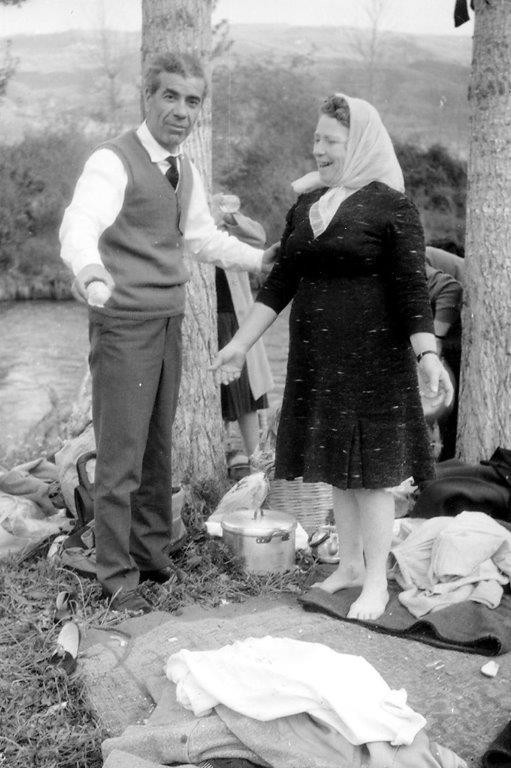
[Husayn and his wife, Fatima on the banks of the Litani River, 1959. With thanks to Ghassan Nasser]
The Lebanese Civil War
When the Lebanese Civil War began in 1975, the LCP was allied to the Lebanese National Movement under the leadership of Kamal Jumblatt, and the party’s militia, the Popular Guard, took part in the early fighting. It supported the Palestinian resistance and believed that Lebanon was a capitalist country in need of a democratic foundation in order to “prepare the ground for the transition to socialism”.[xxi] Muruwwah believed that the crisis in Lebanon was fundamentally one of class struggle. He argued that despite the country’s ostensible independence, it remained subject to a new kind of imperialism, because “the general economic laws that rule in the frame of global imperialism” had not changed.[xxii]
Like most LCP intellectuals, Muruwwah chose to stay in Beirut throughout the civil war. Following the Israeli invasion of 1982 and subsequent siege of the city, Muruwwah was involved in distributing aid to the besieged and continued to write vociferously, documenting the resilience of the city’s inhabitants amidst dire circumstances in a daily column in the LCP’s newspaper, al-Nida’. In the words of the Lebanese poet and playwright, ‘Issam Mahfouz, he became a symbol of Beirut’s sumud (steadfastness and resistance) during the Israeli siege.[xxiii] According to Mary Nassif al-Debs, Muruwwah was also involved in the establishment of the Lebanese National Resistance Front (LNRF) in 1982. The LNRF was a coalition of groups that--until Hezbollah effectively established a monopoly of resistance in the late 1980s--was one of the principal armed resistance groups to Israel active in Lebanon.
Muruwwah’s Assassination
In the middle of the 1980s as the civil war entered its second decade, the LCP was drawn into a bloody conflict with the Syrian-backed movement, Amal. In this context, on 17 February 1987, two men armed with silenced pistols knocked on the door of Muruwwah’s home in the Ramlet al-Baida area of Beirut. Muruwwah’s wife, Fatima answered the door and told the men that he was ill in bed. Regardless, one of them entered Muruwwah’s bedroom and shot him dead. At the time of his assassination, although he was in his late 70s and suffering from Parkinson’s disease, Muruwwah was still a central committee member of the LCP and editor of al-Tariq (positions he had held since 1965 and 1966 respectively). He was also working on the third volume of Materialist Tendencies that he was to never finish.[xxiv]
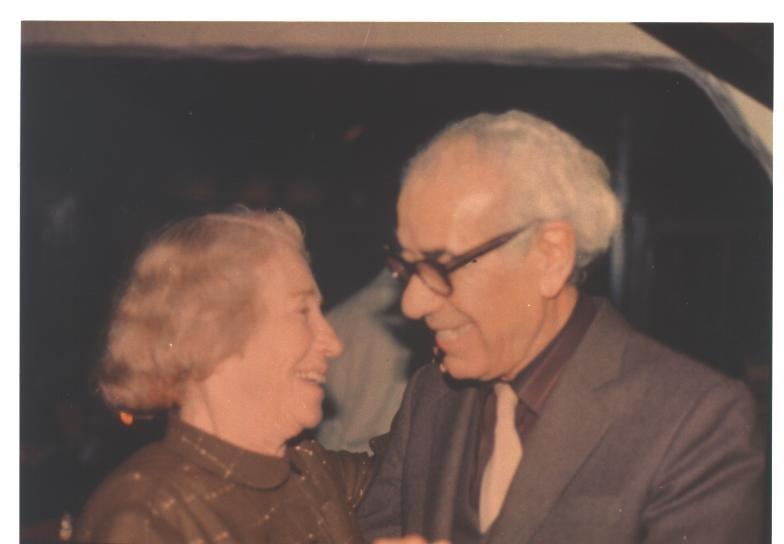
[Husayn with his wife, Fatima, 1980. With thanks to Ghassan Nasser]
Muruwwah’s murder was far from an isolated incident; on the contrary, it came at a time when, following the Israeli siege of Beirut and the PLO’s forced departure from the city in 1982, reactionary forces in Lebanon had begun to systematically target leftist movements in the country and the LCP in particular came under sustained attack. According to the LCP, in the ten days that followed Muruwwah’s killing, over 40 other party members were killed. Three months later, on 18 May 1987, Mahdi ‘Amil (real name Hassan Abdullah Hamdan), a close friend of Muruwwah’s and another towering intellectual figure in the LCP—dubbed "the Arab Gramsci" by Vijay Prashad—was also murdered. It was a period of systematic violence against the Lebanese left from which it has never recovered. There are differing theories as to who was responsible for Muruwwah’s murder—the LCP itself blamed Amal—but like so many events of the Lebanese civil war, the truth has not been established and his killers have never been brought to justice.
The painful reverberations caused by Muruwwah’s assassination and the associated violence of this period, both specifically within his family and more broadly, are explored in the artwork of two of his grandsons, Rabih and Yasser Mroué (who was himself shot by a sniper in Beirut on the same day as his grandfather’s death and left permanently disabled).
Muruwwah’s Legacy
Muruwwah’s ostensible "conversion" from Shi’ism to Communism has unsurprisingly been a topic of great interest. As recently as 2015, a simplistic and inaccurate account of Muruwwah’s supposedly instantaneous ‘conversion’ after reading the Communist Manifesto in 1948 (in which he is said to have immediately shaved his beard and threw off his religious clothes) was published.[xxv] Before that, Silvia Naef asked “[h]ow do members of…religious families break with this sometimes ancient tradition and commit themselves to an ideological line of thought which is, or at least which appears to be, in total contradiction with this tradition?”[xxvi] Yet, as appealing as thoughts of some kind of eureka moment or a dramatic ‘break’ from ancient traditions may be, the reality of Muruwwah’s life is more complex. Ultimately, throughout his intellectual journey, Muruwwah resolutely “insisted on integrating multiple religious, cultural and ideological stances into a new postcolonial intellectual project”, the linchpin of which was a “relentless quest for cultural authenticity in times of modern rupture”.[xxvii] As Di-Capua eloquently concludes, Muruwwah “was not a deserter of ‘religion’ and an embracer of ‘secularism’ or Communism. If anything, his life renders such categories completely obsolete.”[xxviii] Indeed, when one considers that Muruwwah was at once—among many other things—a Shi’a mujtahid, a Soviet-trained Socialist Realist literary critic and a committed Communist revolutionary, one-dimensional categories are swiftly rendered meaningless.
.jpg)
["The great scholar and thinker, Husayn Muruwwah lives on. The martyr of Lebanon, Palestine and the Arab Liberation Movement. The martyr of emancipatory, democratic and progressive thought." Palestine Liberation Organisation poster, 1987. Signs of Conflict Archive, Zeina Maasri Collection]
Muruwwah’s murder was met with genuine shock and he was widely mourned in Lebanon and around the Arab World. The following day, the newspaper al-Safir commented that if the inhabitants of Beirut were already living in moments of great tragedy, then Muruwwah’s assassination was a “tragedy of tragedies”. The LCP’s official announcement remarked defiantly that Muruwwah’s ideas and books would remain a drawn sword in the face of his killers. In an eloquent and moving obituary, his friend and comrade, Mahdi ‘Amil, wrote that Muruwwah was a symbol of the conflict between “the forces of oppression and the forces of freedom, between reason and ignorance”. The Lebanese-American journalist and diplomat, Clovis Maksoud, paid tribute to Muruwwah as a man who had fought tenaciously for over half a century in the name of freedom, unity and equality.[xxix] In the months that followed Muruwwah’s assassination, the Tunisian Marxist, Shukri Bil’id, who in a sad twist of fate was himself assassinated by reactionaries in February 2013, wrote a poem in his comrade’s honour. A short extract from Bil’id’s poem, a fitting tribute to Muruwwah and his legacy, is translated into English (by Nariman Youssef) for the first time:
You are not dead
Author of our journey
Destroyer of sects
And treacherous beards
The shame of the lie
And the lifeless vision
Have spread across the horizon
Qarmati - say a prayer
For the umma of oil and masks
Rise
Hussein of the flag
While we - the tired ones
The ashes of the land
With the soul’s permission
Bid farewell to your body
Let darkness
Have its time
[Note: The secondary literature written on Muruwwah contains a number of contradictory claims regarding the key events of his life and their chronology. With the kind assistance of Ahmad Morowah and Ghassan Nasser, I have attempted to present an accurate account in this article, but any errors that remain are my fault alone.]
Further Reading on Hussein Muruwwah
Abisaab, Rula Jurdi “Deconstructing the Modular and the Authentic: Husayn Muroeh`s Early Islamic History” Critique: Critical Middle Eastern Studies, 17:3 (2008) pp. 239-259
Abisaab, Rula Jurdi & Abissab, Malek The Shi’ites of Lebanon: Modernism, Communism and Hizbullah’s Islamists (New York: Syracuse University Press, 2014)
al-Majlis al-Thaqafi li-Lubnan al-Janubi, Husayn Muruwah: fi masiratihi al-nidalyhah fikran wa-mumarasah (Bayrut: Dar al-Farabi, 1997)
Barakāt Qāsim, Husayn Muruwah, kalimat hayyah (Bayrut: Dar al-Farabi, 2012)
Barhūmah, Mūsá al-Turāth al-ʻArabī wa-al-ʻaql al-māddī : dirāsah fī fikr Ḥusayn Murūwah (Bayrūt: al-Muʾassasah al-ʻArabīyah lil-Dirāsāt wa-al-Nashr, 2004)
Di-Capua, Yoav “Homeward Bound: Husayn Muruwwah’s Integrative Quest for Authenticity” Journal of Arabic Literature 44 (2013) pp. 21-51
Gran, Peter “Islamic Marxism in Comparative History: The Case of Lebanon, Reflections on the Recent Book of Husayn Muruwah” in Stowasser, Barbara Freyer, The Islamic Impulse (London: Croom Helm, 1989) pp. 106-120
Mervin, Sabrina “The Clerics of Jabal ‘Amil and the Reform of Religious Teaching in Najaf Since the Beginning of the 20th Century” in Brunner, Rainer & Ende, Werner (eds.), The Twelver Shia in Modern Times (Brill, 2001) pp. 79-86
Naef, Silvia “Shi’i-Shuyu’i or: How to Become a Communist in a Holy City” in Brunner, Rainer & Ende, Werner (eds.), The Twelver Shia in Modern Times (Brill, 2001) pp. 255-267
Staif, A. N. “The Soviet Impact on Modern Arabic Literary Criticism: Husayn Muruwwa`s Concept of the "New Realism"” Bulletin (British Society for Middle Eastern Studies) Vol. 11, No. 2 (1984), pp. 156-171
Tamari, Steve “Reclaiming the Islamic Heritage: Marxism and Islam in the Thought of Husayn Muruwah” Arab Studies Journal Vol. 3. No. 1 (Spring 1995) pp. 121-129
Yāghī, ʿAbd al-Raḥmān al-Duktūr Ḥusayn Murūwah, adīban nāqidan (ʿAmmān: Dār al-Bashīr, 1998
Younes, Miriam “A Tale of Two Communists: The Revolutionary Projects of the Lebanese Communists Husayn Muruwwa and Mahdi ‘Amil” Arab Studies Journal Vol. 14 No. 1 (Spring 2016) pp. 98-116
Bibliography of Husayn Muruwwah:
Ma’a al-Qāfilah(Bayrūt: Dār Bayrūt, 1952)
Qaḍāyā Adabiyyah (al-Qahira: Dār al-Fikr, 1956)
al-Thawrah al-‘Irāqiyyah (1958)
Dirāsāt naqīyah fi ḍaw` al-manhaj al-wāqiʻī (1965)
al-Nazaʿāt al-māddīyah fī al-falsafah al-ʿArabīyah al-Islāmīyah (Bayrūt: Dār al-Farābī, 1978)
Dirāsāt fī al-islām (Bayrūt: Dār al-Fārābī, 1980)
Fī al-turāth wa-al-sharīʿah (ʿAdan: Dār al-Hamdānī, 1984)
Turāthunā, kayfa naʿrifuh (Bayrūt: Muʾassasat al-Abḥāth al-ʿArabīyah, 1985)
Wulidtu shaykhan wa-amūtu ṭiflan: sīrah dhātīyah fī ḥadīth ajrāhu maʿahu (Bayrūt: Dār al-Farābī, 1990)
Dirāsāt fī al-fikr wa-al-adab (Bayrūt: Dār al-Fārābī, 1993)
[i] There are several other transliterations of his name used including Morowah, Mroue, Mroueh, Murawwa, Muruwah, Mrowa, Muroeh and Mrouweh.
[ii] Di-Capua (2013) p. 37.
[iii] Husayn Muruwwah, “Husayn Muruwwah ‘an ayyam al-harb wa-l-hisar: lam ‘ustati’ al-hayat dun ‘an aktub” al-Nida’, 7 November 1982. Quoted in Miriam Younes, “A Tale of Two Communists: The Revolutionary Projects of the Lebanese Communists Husayn Muruwwa and Mahdi ‘Amil” Arab Studies Journal Vol. 14 No. 1 (Spring 2016) p. 100.
[iv] 1910 is his official date of birth but according to Muruwwah, his father told him that he had actually been born in 1908. Husayn Muruwwah, Wulidtu shaykhan wa-amūtu ṭiflan: sīrah dhātīyah fī ḥadīth ajrāhu maʿahu (Bayrūt: Dār al-Farābī, 1990) p. 21.
[v] Husayn Muruwwa, “Min al-Najaf dakhala hayātī Marx” in al-Majlis al-Thaqāfī li-Lubnān al-Janūbī, Ḥusayn Murūwah: fī masīratihi al-niḍālīyah fikran wa-mumārasah (Bayrūt: Dār al-Fārābī, 1997) p. 89.
[vi] The intentional play in words in this title is lost in English, for in Arabic, as well as a man of religion, Shaykh can also refer generically to someone old.
[vii] al-Majlis al-Thaqāfī li-Lubnān al-Janūbī (1997) p. 90.
[viii] Sabrina Mervin, “The Clerics of Jabal ‘Amil and the Reform of Religious Teaching in Najaf Since the Beginning of the 20th Century” in Brunner, Rainer & Ende, Werner (eds.), The Twelver Shia in Modern Times (Brill, 2001) pp. 79-86.
[ix] al-Irfan (November 1928), quoted in Di Capua (2013) p. 31.
[x] Di-Capua presumes this was Muruwwah’s brother, but Murruwah’s son Ahmad states that it is not known who the money was from and it was not his brother as he had returned from Argentina by that point in time (Email correspondence with Ahmad, January 2017).
[xi] Di-Capua (2013) p. 32.
[xii] Muruwwa (1990) pp. 95-96
[xiii] Di-Capua (2013) p. 36
[xv] Muruwwah (1990) pp. 108, 112.
[xvi] The National Archives, Cabinet Office, CAB132/3: ac (o) (50) 18: report (annex by JIC `Communist Influence in the Middle East`, 21 Apr 1950.
[xvii] Husayn Muruwwah, Qaḍāyā Adabiyyah (al-Qahira: Dār al-Fikr, 1956) pp. 73-74.
[xviii] Di-Capua (2013) p. 24.
[xix] Husayn Muruwwah, Qaḍāyā Adabiyyah (al-Qahira: Dār al-Fikr, 1956) p. 48.
[xx] Tamari (1995) p. 123.
[xxi] Younes (2016) p. 106.
[xxii] Younes (2016) p. 105.
[xxiii] Barakat (2012) p. 110.
[xxiv] Muruwwah (1990) p. 126.
[xxv] Laura U. Marks, Hanan al-Cinema: Affections for the Moving Image (MIT Press, 2015) p.121.
[xxvi] Naef (2001) p. 255.
[xxvii] Di-Capua (2013) p. 24.
[xxviii] Di-Capua (2013) p. 52.
[xxix] Barakat (2012) contains a selection of obituaries and statements that followed Muruwwah’s death (pp. 103-140).